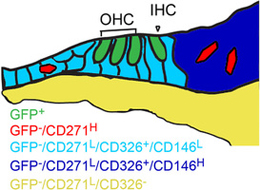Research Abstract
マウス蝸牛支持細胞に備わっている再生能力
Intrinsic regenerative potential of murine cochlear supporting cells
2011年6月29日 Scientific Reports 1 : 26 doi: 10.1038/srep00026

内耳蝸牛に再生能のないことが、難聴・失聴が不治であることの主因である。しかし、新生仔の蝸牛から単離した非聴覚器細胞は、生体内では増殖しないが、培養下では増殖して有毛細胞に似た細胞を生み出せる。とはいえ、非聴覚器細胞のコロニーのうち、有毛細胞様細胞になるのはごく一部であり、これは聴覚器前駆細胞が増殖可能な非聴覚器細胞中の一部に過ぎないことを示唆する。今回、新生マウスの蝸牛から、蛍光励起細胞選別法(FACS)で4種の異なる非聴覚器細胞集団を分離した。4集団とも増殖能を示したが、lesser epithelial ridge由来の細胞と支持細胞だけが、再現性よく有毛細胞マーカー陽性の細胞を生み出した。これらの結果は、蝸牛支持細胞とlesser epithelial ridge由来の細胞が、聴覚前駆細胞へと脱分化した後に、発生期内耳の本来の聴覚前駆細胞と同様な様式で増殖し有毛細胞に分化しうる能力を強く持つことを示唆する。
- スタンフォード大学医学系大学院 耳鼻咽喉科・頭頸部外科(米国)
- スタンフォード大学医学系大学院 分子細胞生理学(米国)
The lack of cochlear regenerative potential is the main cause for the permanence of hearing loss. Albeit quiescent in vivo, dissociated non-sensory cells from the neonatal cochlea proliferate and show ability to generate hair cell-like cells in vitro. Only a few non-sensory cell-derived colonies, however, give rise to hair cell-like cells, suggesting that sensory progenitor cells are a subpopulation of proliferating non-sensory cells. Here we purify from the neonatal mouse cochlea four different non-sensory cell populations by fluorescence-activated cell sorting (FACS). All four populations displayed proliferative potential, but only lesser epithelial ridge and supporting cells robustly gave rise to hair cell marker-positive cells. These results suggest that cochlear supporting cells and cells of the lesser epithelial ridge show robust potential to de-differentiate into prosensory cells that proliferate and undergo differentiation in similar fashion to native prosensory cells of the developing inner ear.

